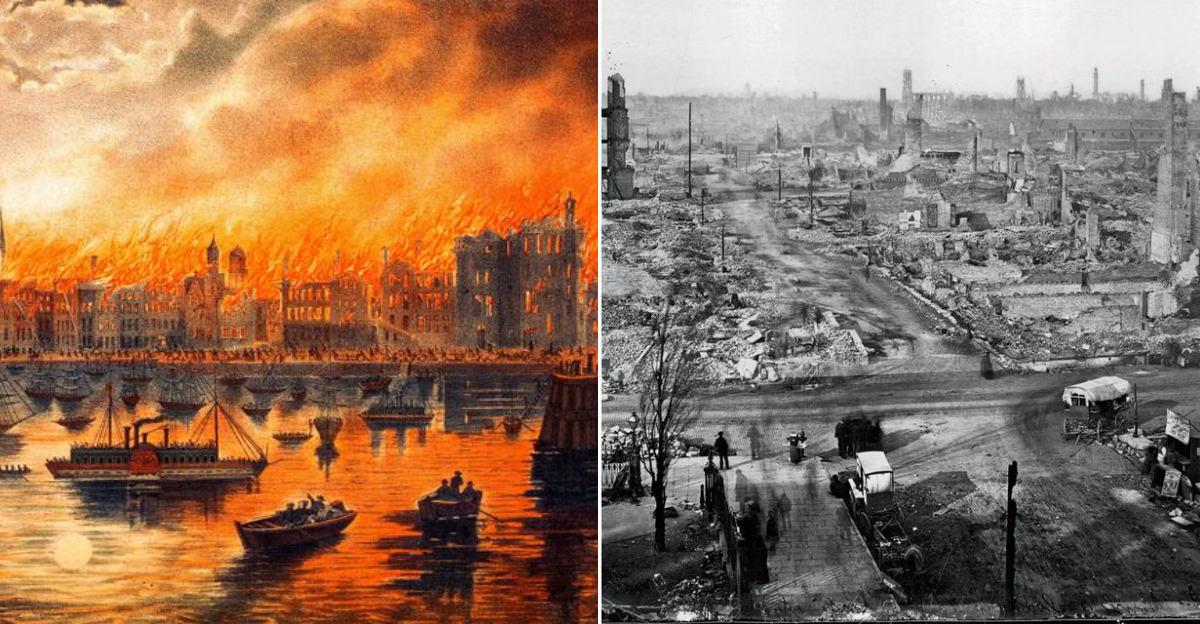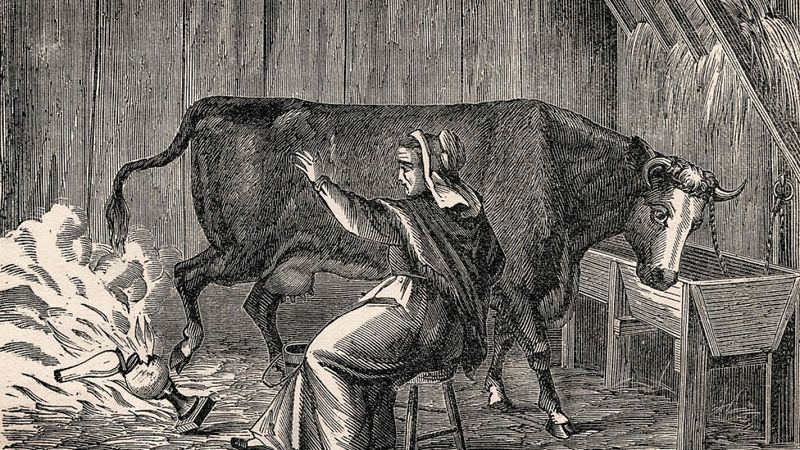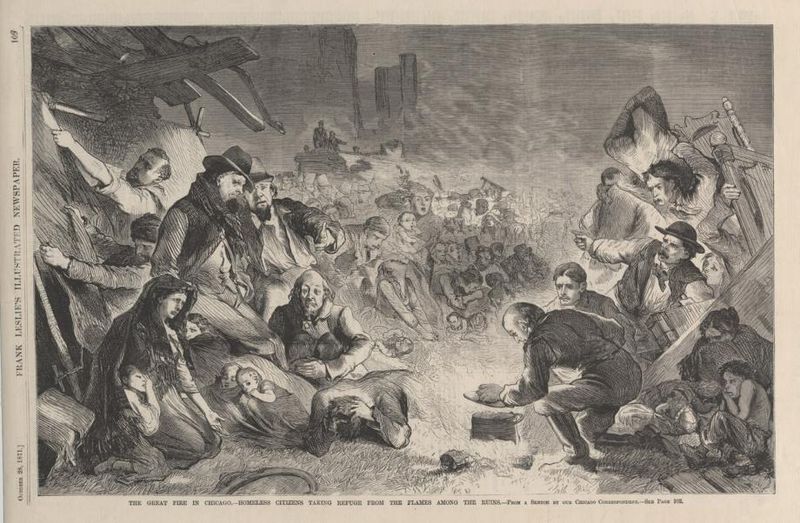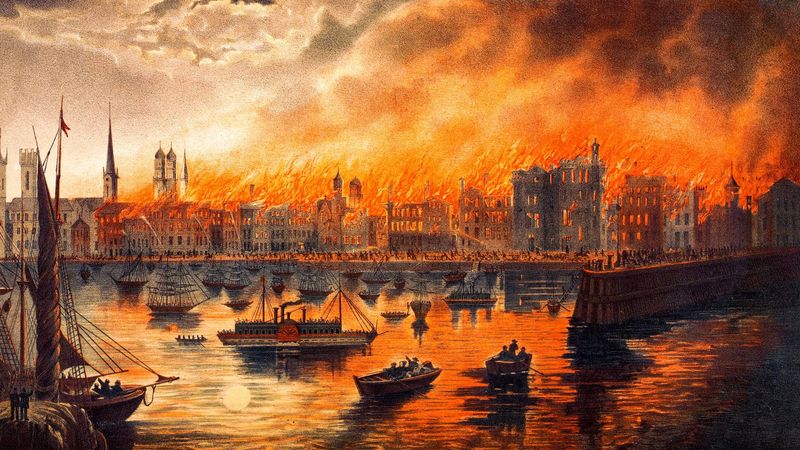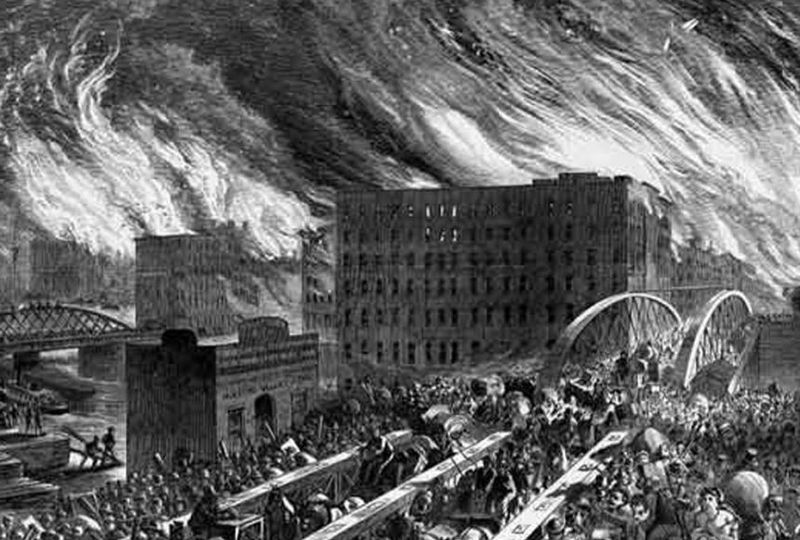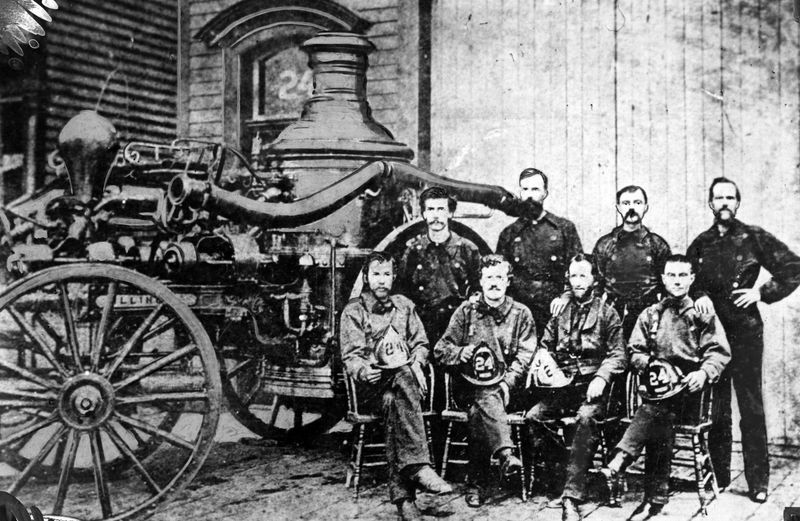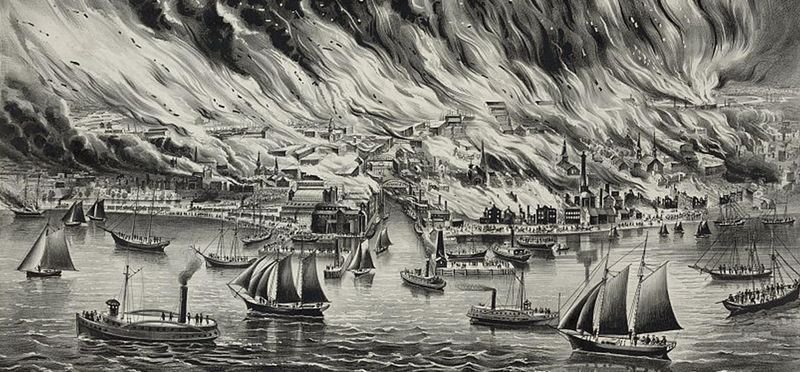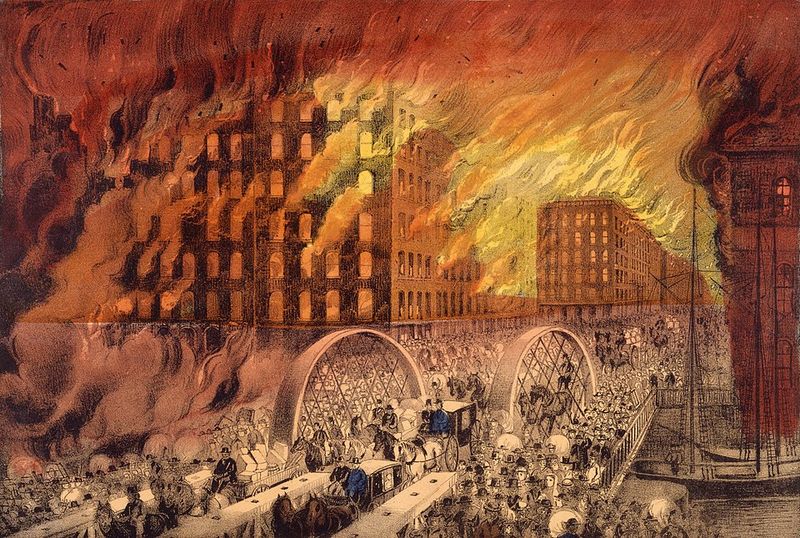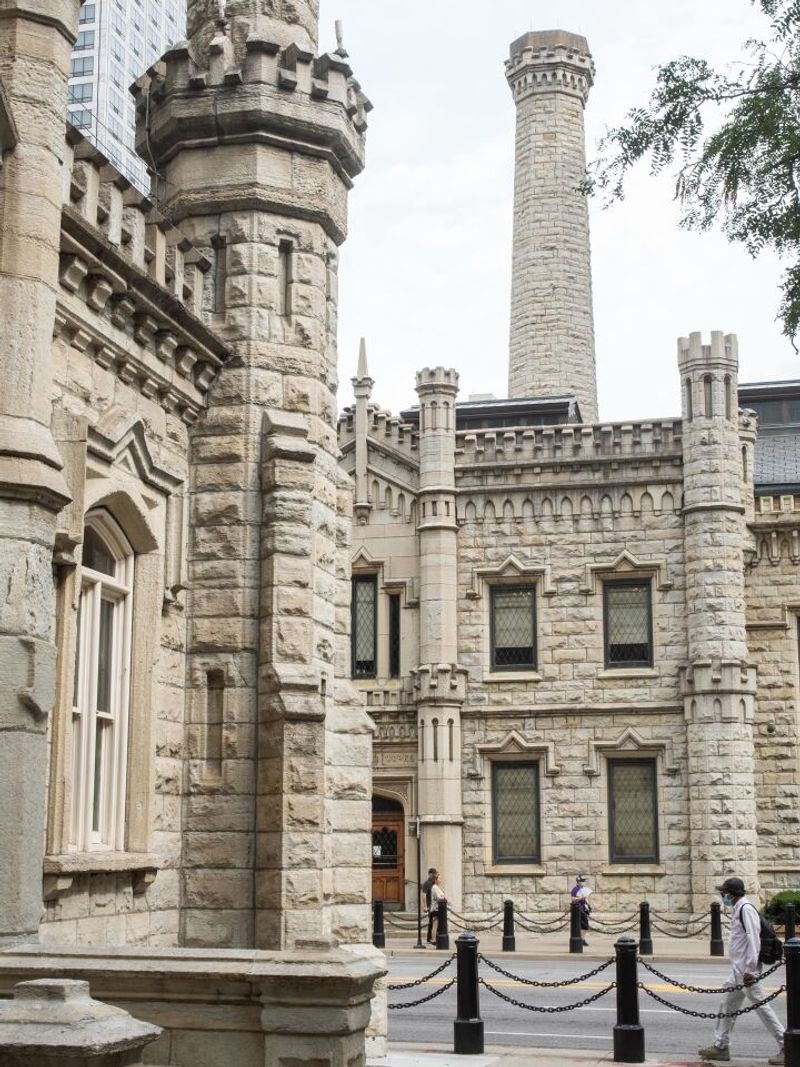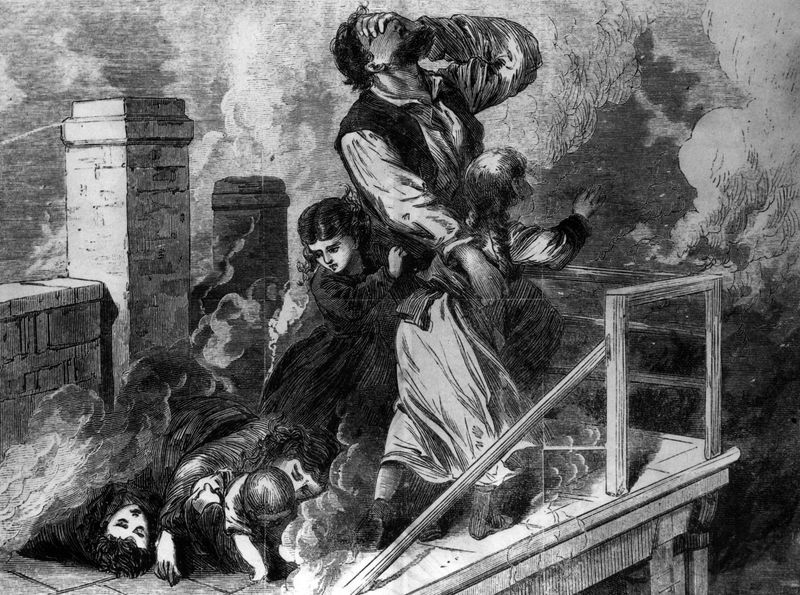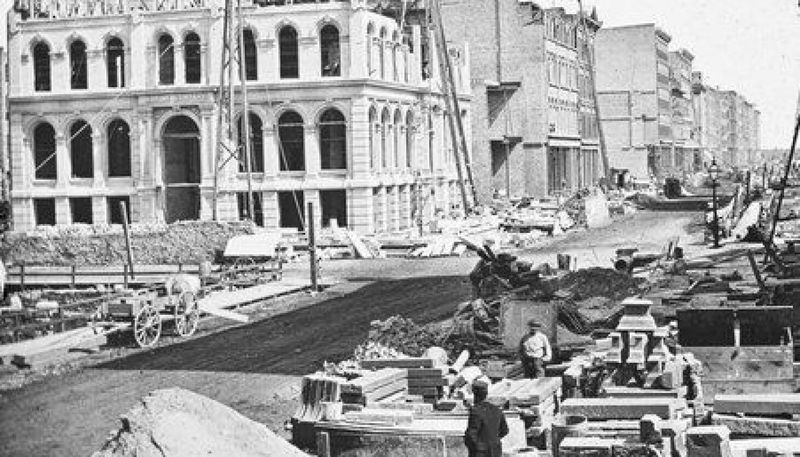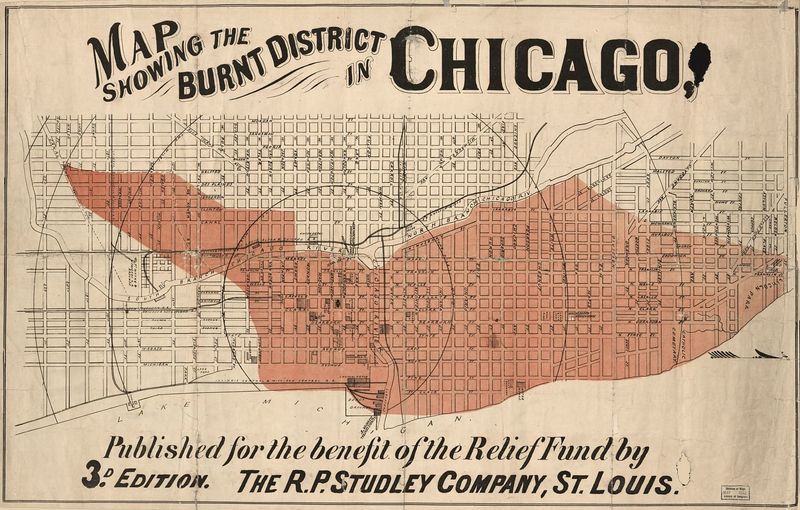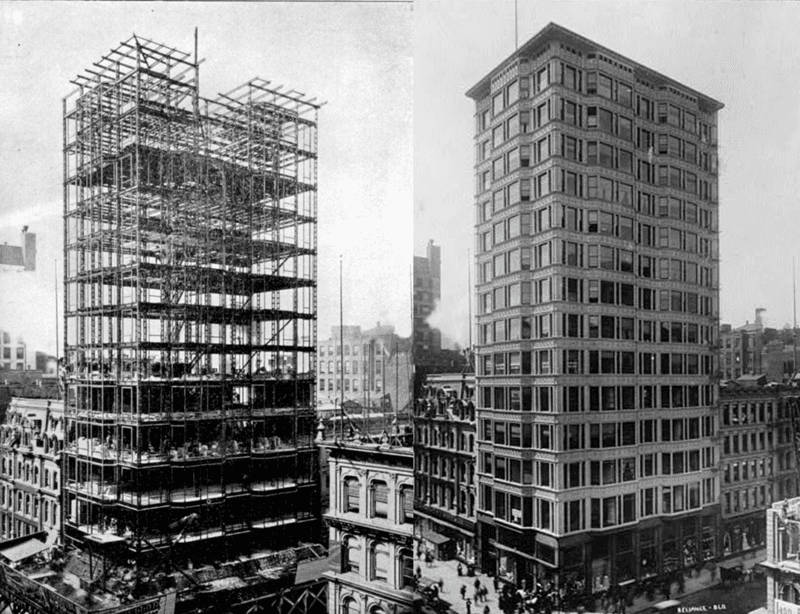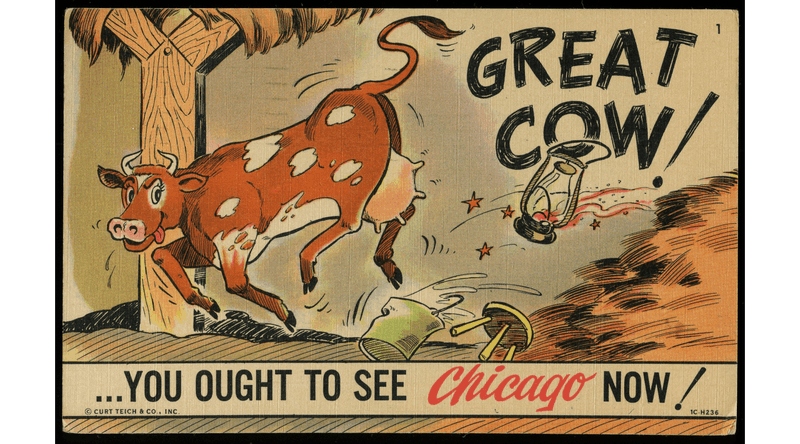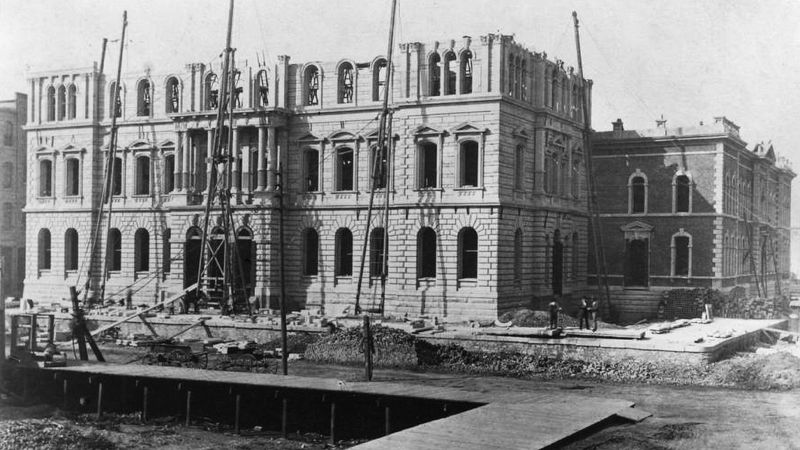It started on a quiet Sunday night—but within days, it would leave a city in ruins and change the course of American history. The Great Chicago Fire of 1871 wasn’t just a disaster; it was a wake-up call for urban America. These 17 facts uncover the chaos, the myths, and the aftermath of one of the most devastating fires in U.S. history.
1. It All Started in a Barn—Or Did It?
Legend says Mrs. O’Leary’s cow kicked over a lantern in her barn on DeKoven Street. The story, however, may be more scapegoating than truth—no solid evidence ever proved it. The real spark remains a mystery.
Historians have debated and debunked this tale over the years. Some suggest local hooligans or even meteor showers might have been to blame.
While the cow story endures in popular culture, the true cause of the fire remains unsolved. The mystery adds a layer of intrigue to this already dramatic event.
2. Over 100,000 People Were Left Homeless
In the aftermath of the inferno, nearly one-third of Chicago’s population found themselves without a roof over their heads. As the flames devoured homes, families fled in desperation. The skyline was marked by smoke and ruin.
Many sought refuge in churches and makeshift tents. The scene was chaotic, with people from all walks of life converging in shared spaces.
The vast displacement highlighted the vulnerability of urban life. It showed how quickly stability could turn into chaos, affecting rich and poor alike.
3. The Fire Raged for Over 30 Hours
Once ignited, the Great Chicago Fire raged with a fury that seemed unstoppable. For over 30 hours, the city was consumed by flames, fueled by strong winds and dry weather.
The fire’s relentless advance left neighborhoods in ashes, transforming familiar streets into desolate wastelands. People watched helplessly as the blaze devoured everything in its path.
The sheer duration of the fire magnified its destructive power, leaving a lasting scar on the city and its inhabitants.
4. Wooden Buildings Made the City a Tinderbox
More than two-thirds of Chicago’s structures were made entirely of wood, including sidewalks and roads. This architectural choice turned the city into a firetrap.
Months-long drought had left the wood bone-dry, creating the perfect conditions for an uncontrollable blaze.
As the fire spread rapidly, the wooden cityscape succumbed to the flames’ appetite. This devastating reality underscored the need for change in urban planning and construction materials.
5. Firefighters Were Already Exhausted
The night before the Great Chicago Fire, a major blaze had already stretched the fire department to its limits. Equipment was damaged, and crews were running on fumes when the big inferno began.
The firefighters’ exhaustion hampered their efforts, making it difficult to control the spread of flames.
Despite their best attempts, the weary firefighters faced an overwhelming challenge. The fire’s ferocity outpaced their capacity to respond, resulting in widespread destruction.
6. Flames Jumped the Chicago River
The Chicago River, a natural barrier, was no match for the Great Fire. High winds and floating debris carried the flames across, expanding the destruction far beyond initial expectations.
People watched in awe and terror as the fire defied logic, spreading with ease to the city’s other side.
This unexpected leap increased the devastation, highlighting the uncontrollable nature of the blaze and its ability to defy conventional boundaries.
7. The Courthouse Bell Rang Until It Fell
As flames consumed the courthouse, its bell tolled continuously—a haunting signal of impending doom. The sound echoed through the city, warning citizens of the fire’s approach.
Eventually, the tower succumbed to the flames, and the bell fell silent, buried under debris.
This poignant moment symbolized the collapse of order and the magnitude of the disaster, leaving an indelible impression on those who witnessed it.
8. Entire Neighborhoods Were Wiped Off the Map
The Great Chicago Fire wiped entire neighborhoods off the map, destroying over 17,000 buildings. Communities, both rich and poor, were flattened in the relentless blaze.
The destruction was indiscriminate, erasing the diverse tapestry of life that characterized Chicago.
The aftermath left a haunting emptiness where vibrant neighborhoods once stood, forever altering the city’s landscape and leaving survivors to rebuild from scratch.
9. Only Two Buildings in the Burn Zone Survived
Amid the devastation, two structures miraculously survived within the main burn area: the iconic Chicago Water Tower and the nearby pumping station. These lone survivors became symbols of resilience.
Their survival seemed almost miraculous, standing defiantly amid the ashes and rubble.
Today, they serve as enduring reminders of the past, representing not only the fire’s destruction but also the city’s enduring spirit and capacity for rebirth.
10. Looting and Lawlessness Took Over
With police overwhelmed and thousands desperate, looting spread across Chicago during the fire. The breakdown of law and order was swift and alarming.
Martial law was declared, and troops were called in to restore order to the chaos-stricken city.
The lawlessness added another layer of fear to an already dire situation, reflecting the social upheaval and desperation faced by the city’s inhabitants.
11. Chicago Rebuilt Faster Than Anyone Expected
Remarkably, the city of Chicago began rebuilding almost immediately after the fire. Architects, laborers, and visionaries poured in, determined to rise from the ashes.
Within days, the foundations for a new Chicago were laid, setting the stage for its transformation into a modern urban center.
The rapid rebuilding demonstrated the city’s resilience and ambition, turning disaster into an opportunity for growth and innovation.
12. The Blaze Cost an Estimated $222 Million
The Great Chicago Fire came with a staggering financial cost, estimated at $222 million—equivalent to around $5 billion today.
Insurance companies balked at the massive claims, leaving many residents financially ruined as they struggled to rebuild their lives.
The economic impact was profound, affecting not only individuals but also the city’s broader economic landscape, challenging its recovery process.
13. The Fire Spurred Major Building Code Reforms
The devastation of the Great Fire highlighted the necessity for better building practices. Cities nationwide took note, implementing major reforms in construction codes.
New regulations banned wooden construction in dense urban areas, promoting safer, more fire-resistant designs.
These changes were instrumental in transforming urban landscapes, setting new standards for safety and influencing modern architecture’s evolution.
14. It Inspired a Skyscraper Revolution
The ashes of the Great Fire paved the way for a new era of architectural innovation. Chicago became a pioneer in skyscraper construction, revolutionizing urban design.
The city’s famous skyline began to take shape, with towering structures that defied gravity and tradition.
This architectural renaissance transformed Chicago into a symbol of modernity and progress, influencing cities worldwide and ushering in a new age of skyscrapers.
15. The Red Cross Made Its First Major Disaster Response
Clara Barton led the Red Cross in its first large-scale disaster response during the aftermath of the Chicago Fire.
The organization’s efforts provided vital aid and relief to the fire’s countless victims, establishing its future role in American disasters.
This pivotal moment in humanitarian history showcased the power of organized relief efforts, setting a precedent for future crises and solidifying the Red Cross’s legacy.
16. A Cow Was Unfairly Blamed for Generations
For generations, Mrs. O’Leary’s cow was blamed for starting the Great Chicago Fire—a tale that, while colorful, lacked factual basis.
Mrs. O’Leary lived with the stigma until her death, maintaining her innocence. In 1997, the Chicago City Council officially cleared her name.
This myth, though debunked, endures in popular culture, highlighting how legends can overshadow truth, affecting lives and reputations.
17. The Fire Forged a New American City
Far from ending Chicago’s story, the fire marked a new beginning. The city’s rapid rebirth turned it into a symbol of American resilience, innovation, and ambition.
Rebuilt with modern infrastructure, Chicago became a model for urban planning and development, setting trends for cities nationwide.
This transformation highlighted the power of human spirit and determination, proving that out of destruction can come extraordinary progress and reinvention.
